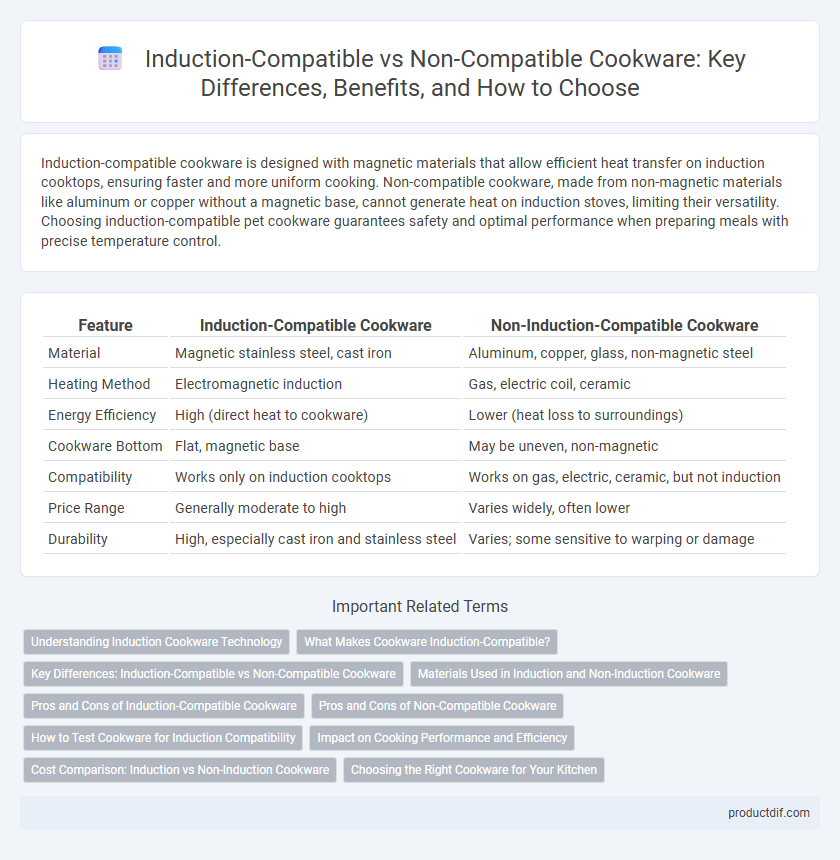Induction-compatible cookware is designed with magnetic materials that allow efficient heat transfer on induction cooktops, ensuring faster and more uniform cooking. Non-compatible cookware, made from non-magnetic materials like aluminum or copper without a magnetic base, cannot generate heat on induction stoves, limiting their versatility. Choosing induction-compatible pet cookware guarantees safety and optimal performance when preparing meals with precise temperature control.
Table of Comparison
| Feature | Induction-Compatible Cookware | Non-Induction-Compatible Cookware |
|---|---|---|
| Material | Magnetic stainless steel, cast iron | Aluminum, copper, glass, non-magnetic steel |
| Heating Method | Electromagnetic induction | Gas, electric coil, ceramic |
| Energy Efficiency | High (direct heat to cookware) | Lower (heat loss to surroundings) |
| Cookware Bottom | Flat, magnetic base | May be uneven, non-magnetic |
| Compatibility | Works only on induction cooktops | Works on gas, electric, ceramic, but not induction |
| Price Range | Generally moderate to high | Varies widely, often lower |
| Durability | High, especially cast iron and stainless steel | Varies; some sensitive to warping or damage |
Understanding Induction Cookware Technology
Induction-compatible cookware features ferromagnetic materials such as cast iron or stainless steel with a magnetic base, enabling efficient heat transfer through electromagnetic induction. Non-compatible cookware lacks this magnetic property, preventing it from heating on induction cooktops. Understanding the magnetic responsiveness and base composition is essential for selecting cookware suited for induction technology.
What Makes Cookware Induction-Compatible?
Induction-compatible cookware requires a magnetic base made from ferrous metals such as cast iron or stainless steel, enabling it to generate heat through electromagnetic induction. The presence of a flat, smooth bottom ensures optimal contact with the induction cooktop, maximizing heat transfer efficiency. Non-compatible cookware lacks magnetic properties or has uneven bottoms, preventing the induction cooktop from activating or distributing heat effectively.
Key Differences: Induction-Compatible vs Non-Compatible Cookware
Induction-compatible cookware features a magnetic base made from materials such as cast iron or stainless steel, enabling efficient heat transfer on induction cooktops. Non-compatible cookware often consists of aluminum, copper, or glass, which lack magnetic properties and do not generate heat on induction surfaces. The key difference lies in the cookware's material composition, directly affecting compatibility and cooking performance on induction stovetops.
Materials Used in Induction and Non-Induction Cookware
Induction-compatible cookware is typically made from magnetic materials such as cast iron, enameled steel, and certain types of stainless steel, which allow the induction cooktop to generate heat efficiently through electromagnetic fields. Non-compatible cookware often consists of non-magnetic materials like aluminum, copper, glass, or ceramic, which do not respond to induction heating unless they have a magnetic base layer added. Understanding the material composition is crucial for selecting cookware that maximizes performance and energy efficiency on induction cooktops.
Pros and Cons of Induction-Compatible Cookware
Induction-compatible cookware, crafted from ferromagnetic materials like cast iron and stainless steel with magnetic bases, offers rapid, even heating and enhanced energy efficiency by directly transferring heat to the pan. This type prevents temperature variability, reduces cooking times, and supports safer stovetop environments due to its cool-to-touch handles and surfaces. However, its higher initial cost and potential incompatibility with non-induction stovetops can limit versatility for some users.
Pros and Cons of Non-Compatible Cookware
Non-compatible cookware often includes materials like glass, aluminum, and copper that lack the magnetic properties necessary for induction cooktops, limiting their versatility on induction stoves. While these pans may offer excellent heat conductivity and are generally lighter or more affordable, they require separate heat sources such as gas or electric coil, reducing their convenience in modern kitchens using induction technology. Users must consider trade-offs between traditional cooking performance and the inability to directly use non-compatible cookware on energy-efficient induction cooktops.
How to Test Cookware for Induction Compatibility
To test cookware for induction compatibility, place a magnet on the bottom of the pan; a strong magnetic attraction indicates it is induction-compatible. Cookware made from ferromagnetic materials such as cast iron or stainless steel with magnetic properties will work on induction cooktops, while aluminum, copper, or glass pans typically do not. Testing with a magnet provides a simple, reliable method to determine whether pots or pans can efficiently generate heat on an induction stove.
Impact on Cooking Performance and Efficiency
Induction-compatible cookware significantly enhances cooking performance and efficiency by providing faster, more even heat distribution directly through magnetic induction, reducing energy waste. Non-compatible cookware, typically made from materials like aluminum or copper without a magnetic base, results in slower heating and uneven cooking, leading to longer cooking times and increased energy consumption. Choosing induction-compatible pots and pans ensures optimal energy use and precise temperature control, improving overall kitchen productivity.
Cost Comparison: Induction vs Non-Induction Cookware
Induction-compatible cookware typically costs more upfront due to the requirement for magnetic materials such as stainless steel or cast iron, which are engineered to work with induction cooktops. Non-induction cookware, often made from aluminum or copper, is generally less expensive but may necessitate replacement sooner as it is not compatible with modern induction technology. Long-term cost efficiency favors induction-compatible sets for their durability and energy-saving capabilities despite higher initial investments.
Choosing the Right Cookware for Your Kitchen
Induction-compatible cookware features a magnetic base made from materials like stainless steel or cast iron, ensuring efficient heat transfer on induction cooktops. Non-compatible cookware, often made from aluminum, copper, or glass, fails to work with induction technology due to lack of magnetism. Choosing the right cookware involves verifying compatibility with your cooktop type to maximize cooking efficiency and durability.
Induction-Compatible vs Non-Compatible Infographic

 productdif.com
productdif.com